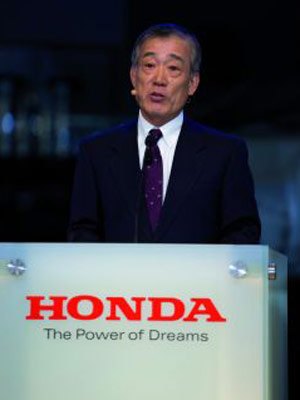Honda Outlines Three-year Plan

Honda outlines three-year plan
Honda began its business with motorcycles, entered into the global market with motorcycles, and established a business foundation which later enabled Honda to enter into the automobile business, says Fukui. Motorcycle business is the driving force of Hondas growth and expansion, and it is one of the key strengths of Honda that other automakers do not have.
Fukui presented his companys three-year plan for growth in a speech in Tokyo on May 21, listing the strength of Hondas motorcycle division as one of the core areas in improving the companys manufacturing process and becoming a leader in environmental technologies.
With rising fuel costs and increased concerns over the environment, Honda plans to install its Programmed Fuel Injection (PGM-FI) system on all motorcycles by 2010. Already installed on nearly all Honda scooters sold in Japan, the PGM-FI is a less bulky and cheaper to produce than the conventional fuel injection systems used on Hondas larger motorcycles while producing fewer emissions.
Honda will also introduce a Variable Cylinder Management (VCM) system to improve fuel efficiency. Already used in Hondas 2008 Accord, the VCM is a variable displacement system that improves fuel efficiency by deactivating engine cylinders under specific riding conditions. In the six-cylinder Accord, the VCM can deactivate two to three cylinders at a time without a perceptible drop in power delivery.
Honda motorcycles will also see improvements in safety technology. Fukui says the company will install its motorcycle airbag system on more models. Honda also plans to install an antilock brake system (ABS) in 250cc or larger motorcycles, except off-road models, by 2010. As well, Honda will introduce its combined ABS (C-ABS) system. Already availabe for some models such as the ST1300, Honda says the electronically-controlled C-ABS system produces 2.3 times the amount of deceleration produced by conventional brakes.
Fukui says Honda will also produce a new 100cc bike for the Asian market where small-displacement bikes like Hondas Super Cub are popular.
Demand for motorcycles as a means of transportation is expected to continue to grow mainly in Asian and South American nations. In addition, considering the global high price of crude oil, there is a good chance that motorcycles will be considered not only in developing countries but on a global basis, says Fukui. Honda will create motorcycle products which reflect the unique characteristics of Honda and exceed the expectations of customers while striving to develop another model which creates a new motorcycle category and market as did the Super Cub.
Related Reading
Honda Pulls Plug On Bike Production in U.S.
Honda produces 60 millionth Cub

Motorcycle.com presents an unrivaled combination of bike reviews and news written by industry experts
More by Motorcycle.com Staff




























Comments
Join the conversation